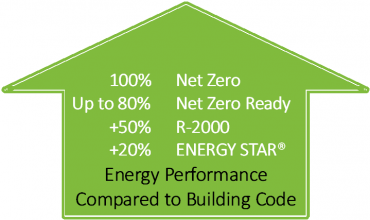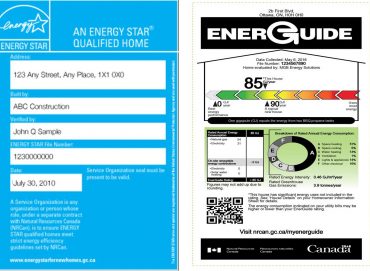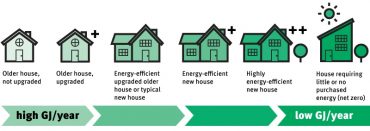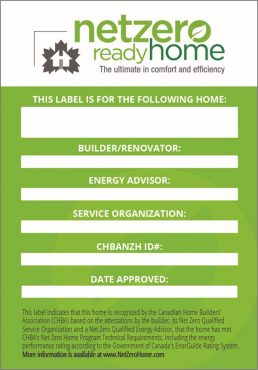
John Bleasby
NEW SERIES: The Road to NZE (Net Zero Energy)
Canadian ContractorPart One: Whole-house insulation ratings are shaping the way homes are built
Building code amendments requiring Net Zero Energy ready (NZE-r) home construction are destined to be a reality across Canada by 2030. In this new series, Canadian Contractor considers how far the home building industry still has to go as we move towards that destination. Turns out, maybe not be that far at all!
Whole-house energy performance is now being rated and labelled the same way we’ve seen for years on everyday appliances. EnerGuide (a rating that states a home’s energy performance) and ENERGY STAR (labeling that recognizes homes that exceed code requirements) are already being adopted in parts of the country like British Columbia and the City of Edmonton.
John Bleasby spoke with Sonja Winkelmann, Director, Net Zero Energy Housing at the Canadian Home Builders’ Association (CHBA) in Ottawa, to find out how builders can start adjusting to a new reality.
Currently in terms of insulation requirements across the country, we have building codes based on individual component ratings. Yet NZE is more of a whole-house concept. Are the EnerGuide/ENERGY STAR rating systems meant to bridge the gap and direct the industry towards the NZE objective for 2030?

This CHBA illustration indicates the levels of efficiency that can be achieved
What EnerGuide allows us to do is rate the whole house as a system. The software offered through EnerGuide is the modelling tool that allows the input of all the different variables, for example what kind of windows, what kind of thermal breaks. All that information goes into the EnerGuide modelling so you can determine the whole house envelope performance. Using that tool is what you can use for the performance path for ENERGY STAR, and R-2000. We use it for our NZE program, and out West for BuiltGreen. LEEDS also uses it for one of the ways to show performance.
It seems a bit confusing, all these rating systems.
The confusion with the labels (EnerGuide, ENERGY STAR) has more to do with the fact that we need to improve out marketing of them. Look at the automotive industry; how many brands of cars are there, yet there is no problem differentiating a Porsche and a Chevy. We just need to do a better job telling people about these programs.

The EnerGuide label (right) gives a rating of energy performance in gigajoules. The ENERGY STAR label (left) recognizes a home that exceeds building code requirements.
EnerGuide and ENERGY STAR are currently only voluntary. Is mandatory labeling required to move the process forward and develop more awareness and acceptance?
We are, in fact, at the point now where the government is looking at mandatory rating labeling for all houses, and they’re considering using EnerGuide. The City Edmonton is already going down that road. They want to get a jump and incentivize the program by getting all homes rated with an EnerGuide label so people are familiar with it. It’s a perfect tool to develop energy literacy with consumer audiences. The labeling itself has been improved, making it more intuitive for consumers to compare an EnerGuide-rated house to one that was built to code only.
What are the advantages for the builders?
What builders don’t immediately recognize is that if labeling did become mandatory, it would put new houses at an advantage over existing ones, which is usually their main competition. Newer houses are being built to a higher level of energy efficiency than older homes were. If consumers had the energy literacy to understand that an EnerGuide 50 rating is better than an EnerGuide 200 rating, and if they were able to correlate that EnerGuide rating to their monthly utility

The City of Edmonton is adopting a whole-home energy-efficiency awareness program to encourage improved performance
bills, then all of a sudden we’re going to see consumers choose new homes over existing homes if it makes a significant difference for them.
What are the CHBA’s areas of concerns in terms of mandatory EnerGuide labeling and the NZE objective?
Our concern at the CHBA is affordability. Even without Net Zero we’re seeing an affordability issue already. There are all sorts of other interest groups trying to get things into houses like arc-fault breakers for all outlets and sprinklers which will ultimately make homes safer. However in terms of incidents and costs, there’s got to be a cost-benefit, including for Net Zero. We have to prove that Net Zero is affordable. We as an industry can help do that through the voluntary EnerGuide labeling program.

The ultimate goal for the CHBA is Net Zero Energy-ready (NZE-r) certification for all new homes
Is there an opportunity for builders to get on-board now, rather than waiting for mandatory measures?
We’re in the early-adopter stage. We need to accelerate the opportunity to capitalize on this voluntary program and to bridge the gap between the innovators and the majority of the market. And then we need to address the cost. This is the opportunity now for us as an industry as a whole to really work out those kinks. When we were writing out Net Zero pilot program over the past year, what we found when we spoke to builders leaving the training program was that a majority of them, if not all of them, were walking away saying, “I didn’t know that I was that close to being Net Zero ready.” My message to the builders is that this isn’t something to be afraid of, it’s not something that will be extremely onerous. Yes it’s a change but it’s a change they are capable of making.
This series ‘The Road to NZE’, will continue by looking at at specific measures that can be taken today to improve whole-house energy efficiency through component and material choices, and modified building techniques.
Learn more…
The Centre for Energy Advancement through Technological Innovation (CEATI)
ENERGY EFFICIENT HOUSING Reference Guide
Natural Resource Canada
How the EnerGuide rating system works
Natural Resource Canada
Which EnerGuide rating system applies in your province
Follow John on Instagram and on Twitter for notifications about our newest posts



Leave a Reply